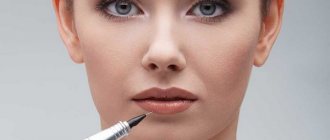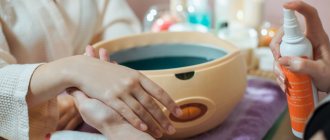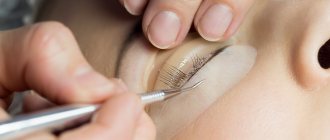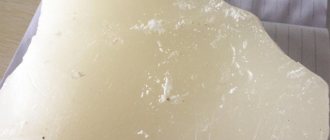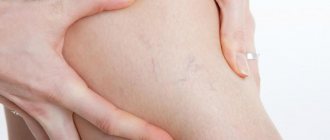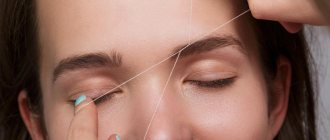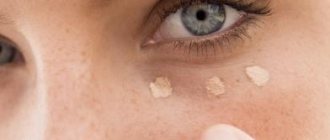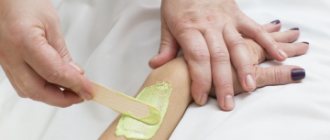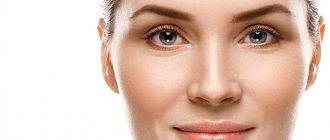It is simply impossible to achieve a perfect manicure and smooth hand skin without deep and systemic moisturizing. The paraffin therapy procedure, which can be done both at home and in the salon, copes with the task. It seems to seal moisture in the upper layers of the skin, soften, relax, relieve pain and irritation. We will talk about these and other features of the procedure, as well as the stages of its implementation, further in detail.
What is paraffin therapy, its types
The paraffin therapy procedure can be divided into two main categories - therapeutic and cosmetic options.
The first is carried out under the supervision of phthisiatricians, and the second is offered as a care procedure in spa centers, beauty salons, and simply for home use.
In general, this is a physiotherapeutic procedure, which is based on the effect of heat on the superficial and deep layers of the skin, muscles and joints.
- Therapeutic paraffin therapy is prescribed as a set of procedures to improve metabolism in tissues and relieve inflammatory processes in joints. It is also an excellent preparation for therapeutic massage.
- Cosmetological paraffin therapy for hands is a simplified version of treatment and provides the opportunity for high-quality and effective skin care, as well as relaxation of muscle tension.
The effect is achieved by applying several layers of paraffin heated to a liquid state. The effect of a warm mask is prolonged by using plastic gloves and terry mittens or towels for 15 to 40 minutes.
Recommended intensity
How often can and should you do paraffin therapy for your feet? In emergency cases, when you need to quickly restore, moisturize and nourish the skin of your feet, you can do 3 procedures per week.
The recommended average intensity is a course of 3-10 procedures over 1-2 months with an intensity of first 2 and then 1 procedure per week.
To maintain well-groomed condition of the skin of the legs, 2-3 procedures per month are enough. They may coincide with a pedicure procedure when you visit a salon. Between pedicure procedures and paraffin therapy of the feet, systematic home care for the skin of the feet should be carried out using creams and nourishing masks, especially during periods of increased stress on the feet.
Who is paraffin therapy recommended for: 10 popular cases
The procedure will be extremely useful in the following situations:
- If you have dry, cracked hand skin
- The skin is often exposed to temperature changes (during the off-season and winter)
- You don't use gloves when doing housework
- Frequently expose your hands to chemical detergents and water
- Need to quickly get your hands in order before an important event or event
- How to thoroughly prepare and warm up before a hand massage
- As one of the stages of performing a spa manicure in a salon
- It is necessary to relieve mild redness and irritation caused by dry skin.
- To relieve mild joint pain due to arthritis or minor sprains
- I want to relax, take care of myself and lift my spirits.
Types of SPA manicure, how it is done and necessary cosmetics
Paraffin therapy for hands at home: benefits and contraindications
Cosmetic paraffin is an excellent product for home spa treatments.
It is highly purified and does not contain harmful impurities, artificial colors or fragrances. For greater effectiveness, the product includes vitamin complexes, beneficial microelements and mineral supplements. On sale you can find a product based on honey, vegetable, fruit or oil. When choosing a product, you need to take into account the condition of your skin and nails. A product with extracts of lemon, orange or grapefruit tones, refreshes, disinfects small wounds and accelerates their healing. Chocolate is suitable for deep nutrition and recovery, as well as relaxing aromatherapy. A product with tocopherol and tea rose extract revives sagging, aging skin, and a product based on peach oil is suitable for people prone to allergies and irritations.
Paraffin in the form of briquettes packaged in polyethylene can be purchased at pharmacies or stores offering products for beauty salons. The service is not cheap, but clients who have already tried the procedure leave excellent reviews about it. When used correctly, heated paraffin can
- remove peeling, abrasion, redness;
- make the skin soft, elastic, elastic;
- accelerate the healing of small wounds;
- smooth out wrinkles, lighten age spots;
- get rid of excessive dry skin that conventional creams cannot cope with;
- prevent peeling and brittleness of nails.
Hot paraffin can cure some joint diseases, accompanied by constant or periodic pain and limited mobility. The drug will have a slight lymphatic drainage effect, remove swelling and swelling. In order for the procedure to bring maximum benefit, it is done in courses, followed by a break. Hot baths of molten paraffin will complement a regular manicure and enhance its beneficial effect. The standard course for hand skin restoration is 10 procedures. Paraffin baths and wraps are especially useful during the cold season. They will not only improve the condition of the skin and nails, but also protect against colds.
Paraffin wraps are recommended for dull, aging skin that has lost its tone and elasticity.
Despite its high efficiency and undoubted benefits, paraffin therapy also has contraindications. It cannot be done when
- skin diseases (infectious or fungal);
- psoriasis, eczema, atopic dermatitis;
- extensive wounds, ulcers, inflammations;
- arterial hypertension;
- severe form of diabetes mellitus;
- tendency to varicose veins;
- gynecological diseases;
- allergies to paraffin.
Contraindications
It is better for you to abandon paraffin therapy for your hands and find other analogues of care for the following conditions or diseases:
- Poor blood circulation in the extremities
- Hand numbness
- Wounds, burns
- Infectious inflammations
- Rash, redness of unknown origin
- Severe allergic reactions to cosmetics
- High blood pressure
- Diabetes
- Increased sensitivity of the skin of the hands.
Hot manicure - how to do it, what products are needed
Indications for the use of paraffin therapy
Indications for paraffin therapy at home are divided into cosmetic and medical. Medical indications include the following diseases:
- dysfunctions of the musculoskeletal system (arthritis, radiculitis, fractures, sprains and ruptures of ligaments);
- skin diseases;
- varicose veins;
- trophic ulcers;
- frostbite and burns;
- gynecological diseases in women;
- severe diseases of internal organs;
- polio.
Cosmetic procedures in the salon or at home are performed for the following problems:
- severe dry skin;
- tendency to edema;
- age-related changes (ptosis of the oval face, double chin);
- premature aging;
- expression wrinkles;
- deep creases and folds;
- aging of the hands;
- cellulite;
- cicatricial skin changes.
Carrying out the procedure
Is special training needed?
Yes, it won’t take much time and will better prepare the skin for the procedure. Before paraffin therapy, wash your hands thoroughly with soap. Remove rings and other jewelry, remove clothing from the possible treatment area.
If the procedure precedes a manicure, then you need to remove the nail polish and treat your hands with a fine scrub. Apply a light nourishing or moisturizing cream. Its impact will increase significantly under a paraffin mask due to the greenhouse effect. Now you can get started.
Bath or paraffin heater
There are models for professional and home use. They differ in the number of modes, power and capacity. Usually the bath has two modes - heating and maintaining temperature. In professional conditions, in the second mode, it can stand for up to 10 hours in a row, with a large flow of clients, so as not to reheat the paraffin every time. The average cost of a bath is 2,000 rubles.
The paraffin in the bath should be changed every 2-3 months with an average flow of clients. There is a recommended filling level for the container, which is from 1.5 to 2.5 liters of paraffin. Depending on this, you will have to constantly add new briquettes.
Paraffin used for masks removed from hands is disposed of; it is not returned to the container. Read more about baths for paraffin therapy, their choice and features of use.
How to do it at home: step by step guide
For the procedure you will need:
- Container to melt paraffin
- Paper napkins or towels, terry towel or mittens
- Polyethylene gloves
- Paraffin at the rate of 150-200 g per procedure
- Brush for hard to reach areas
- A container or bath for paraffin to carry out the procedure. About how to choose and correctly use a paraffin bath.
Stages of paraffin therapy:
- Melt the paraffin in the microwave or in a water bath to a temperature of 45-55 degrees. The task is simplified if you have a special bath. It will adjust the temperature automatically.
- Test the temperature of the product on the back of your hand. If you plan to use oils, vitamins or other supplements, mix them with liquid paraffin.
- Place your hands up to your hands in the container for 5 seconds, then take it out and wait 5-10 seconds for the layer to harden well.
- Repeat the previous steps 5 to 10 times.
- Take your hands and put plastic bags or mittens on the still warm, but already frozen wax.
- Put terry mittens over them or wrap your hands in a towel.
- Find a comfortable position and wait 15 to 40 minutes for maximum effect. Often 30 minutes is enough.
- Remove the paraffin masks from the wrist to the fingers.
- Remove any remaining paraffin with paper towels, lightly rinse your hands with water and blot with a napkin to remove the film of toxins and breakdown products from the skin regeneration process.
- Apply nourishing cream or cosmetic oil to your hands and cuticle skin. Now the pores of the skin are open for the effective influence of caring and medicinal cosmetics.
- Give a light or intense hand massage at your discretion.
How to do paraffin therapy for the face and the necessary products
How to make a paraffin face mask correctly -
Important: for the procedure, only special cosmetic wax is used specifically for the face, intended specifically for use at home.
You must carefully read the instructions for the wax, and pay special attention to the temperature to which it needs to be heated. Paraffin facial therapy: video
How is the procedure performed? –
- The skin of the face and neck must be cleansed with a special cleanser. Thorough washing ensures that dirt, dust, and traces of cosmetics do not clog pores and cause inflammation.
- Before applying a paraffin face mask, reviews from some cosmetologists recommend applying a cosmetic cream or lotion to the skin, which will help additionally nourish the skin with beneficial substances. You can also add your favorite cosmetic and essential oils to the paraffin itself, which will provide additional effects to the procedure.
- Heat the wax in a paraffin bath to the desired temperature. Before applying to the face, check the temperature of the paraffin. To do this, it is recommended to apply heated paraffin to the back of your hand - it should be pleasantly warm, but not hot.
- Warm paraffin is applied to the facial skin with a special brush, along massage lines, avoiding the eye area, mouth and around the nose, so that you can breathe freely during the procedure. Start applying paraffin from the middle of the chin, moving up to the cheeks and ears. The chin is covered last.
- Typically 3-4 layers of paraffin are applied, and the resulting paraffin face mask should be about 5mm thick. Paraffin wax may be too thin and drip, so use old or unwanted T-shirts during the procedure.
- Typically, a paraffin facial mask should remain on your skin for 10-15 minutes or until it sets completely. After which it is carefully removed from the face completely or in parts, starting from the chin.
- After the procedure, it is recommended to apply a moisturizer to the skin. In winter, after the procedure, it is not recommended to go outside for an hour.
The effect of paraffin therapy
After the procedure, the skin is moisturized, smoothed, cell regeneration occurs and toxins are cleansed.
- Moisturizing is achieved due to the greenhouse effect of paraffin therapy. Heat leads to the expansion of pores and the space between cells, sweat and toxins are released, and the paraffin layer does not allow the liquid to evaporate, returning it again to dry areas. Moisture again penetrates into those cells that need it most. If you also apply an additional moisturizer, its effect will enhance the moisturizing effect.
- The skin is cleansed of toxins due to increased blood and lymph flow. They are released with sweat, but are not absorbed back, but settle on the surface.
- The skin smoothes out and takes on a healthy appearance, swelling goes away due to the removal of excess fluid and decay products from the cells.
- The process of cell and tissue restoration occurs due to increased blood flow. They receive maximum nutrients during and after the procedure from the effects of cosmetic products.
What are cosmetic electric mittens and how to use them
Cosmetic paraffin: features
Paraffin is formed during the processing of petroleum products. After purification from organic impurities, you can obtain several types of paraffin:
• technical, familiar to us by its presence in candles; • medical - very well cleaned. Used in physiotherapy; • cosmetic paraffin - very well purified with a large number of useful additives (vitamins, oils, fragrances).
Let's talk separately about active additives - why are they included in the substance? Oils intensively moisturize the skin and smooth out wrinkles. Vitamins promote the renewal of skin cells and also create a protective barrier on it. If you are allergic to any of the components of the composition, then you can use paraffin without any additives at all - even such a “simple” composition will perfectly moisturize your feet by creating a greenhouse effect.
Healthy Supplements
In many salons, herbal extracts of aloe, lavender, mint, citrus fruits, and tea tree are added to cosmetic paraffin. Vitamins E and A are used, which help restore and nourish the upper layers of the skin.
You can experiment with a number of additives, for example, coconut or shea butter, chocolate, just do a test for an allergic reaction first.
Paraffin for hot and cold paraffin therapy - review of the best
What paraffin is used in paraffin therapy?
Many people have heard about the hot paraffin therapy method. But there is also a method when the already cooled product is applied to the skin. Cold paraffin therapy is considered a complex method, so it is easier to follow the classical scheme: heat the product and apply a liquid solidifying mass to the body.
Manufacturers add ready-made compounds to paraffins, which themselves have a healing effect. For example, the addition of vitamins stimulates skin regeneration, nourishes and moisturizes the epidermis. Seaweed extract effectively fights cellulite. But even without adding additional ingredients, the paraffin mass has a beneficial effect on the skin.
Useful tips
A number of proven tips will make the procedure even more effective.
- The more layers of paraffin you apply to your hands, the easier it will be to remove and the longer the warmth will last. Some masters increase the number of layers to 10 or 12.
- To relieve pain in the joints and wrists, the number of layers should reach 15.
- Place your hands at the same level each time to create a thick edge along the edge. It will be much easier for you to remove the paraffin.
- Do not move your fingers between dips to prevent cracks from forming in the layers.
- If you have dry hands, be sure to apply a moisturizing or nourishing cream to the entire surface and additionally in the cuticle area.
- In detail about what materials, products and accessories are needed for paraffin therapy, as well as the choice of paraffin.
Materials for the procedure in the salon
If you are performing the procedure at home for yourself or for clients who have had pedicures, vary the list accordingly. A basic set for paraffin therapy of the feet, which the specialist will need in the salon:
- Disposable gloves;
- Hand sanitizer and foot sanitizer;
- Paraffin bath for the procedure;
- Plastic bags for feet;
- Terry socks or felt boots (can be replaced with a terry towel);
- Brush for working hard-to-reach areas;
- Medium grind scrub;
- Acid scrub or keratolytic;
- Coconut oil or nourishing cream;
- Paraffin in briquettes per procedure.
Paraffin therapy kit: what a master needs for the procedure
Coconut oil can be replaced with cocoa or olive oil. It will be required for application to the skin before immersion in paraffin. For dry skin on the feet and small cracks, you can additionally use Panthenol, applying it before applying the oil. You can also use sea buckthorn oil for small cracks; it has a pronounced healing effect.
